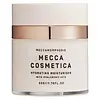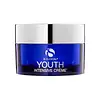What's inside
What's inside
 Key Ingredients
Key Ingredients

 Benefits
Benefits

 Concerns
Concerns

 Ingredients Side-by-side
Ingredients Side-by-side

Water
Skin ConditioningC12-15 Alkyl Benzoate
AntimicrobialGlycerin
HumectantCaprylic/Capric Triglyceride
MaskingMyristyl Myristate
EmollientCetearyl Alcohol
EmollientCetyl Alcohol
EmollientStearic Acid
CleansingDimethicone
EmollientButyrospermum Parkii Butter
Skin ConditioningGlyceryl Stearate
EmollientCeteareth-20
CleansingSodium Acrylate/Sodium Acryloyldimethyl Taurate Copolymer
Emulsion StabilisingPhenoxyethanol
PreservativeTocopheryl Acetate
AntioxidantIsohexadecane
EmollientCaprylyl Glycol
EmollientPentylene Glycol
Skin ConditioningXanthan Gum
EmulsifyingEthylhexylglycerin
Skin ConditioningParfum
MaskingPolysorbate 80
EmulsifyingHydrolyzed Rice Protein
Skin ConditioningFructose
HumectantUrea
BufferingCitric Acid
BufferingSodium Hydroxide
BufferingHydrolyzed Pea Protein
EmollientMaltose
MaskingSodium PCA
HumectantSodium Chloride
MaskingSodium Lactate
BufferingTrehalose
HumectantAllantoin
Skin ConditioningGlycine
BufferingProline
Skin ConditioningHydrolyzed Sodium Hyaluronate
Skin ConditioningDisodium EDTA
Sodium Hyaluronate
HumectantGlucose
HumectantWater, C12-15 Alkyl Benzoate, Glycerin, Caprylic/Capric Triglyceride, Myristyl Myristate, Cetearyl Alcohol, Cetyl Alcohol, Stearic Acid, Dimethicone, Butyrospermum Parkii Butter, Glyceryl Stearate, Ceteareth-20, Sodium Acrylate/Sodium Acryloyldimethyl Taurate Copolymer, Phenoxyethanol, Tocopheryl Acetate, Isohexadecane, Caprylyl Glycol, Pentylene Glycol, Xanthan Gum, Ethylhexylglycerin, Parfum, Polysorbate 80, Hydrolyzed Rice Protein, Fructose, Urea, Citric Acid, Sodium Hydroxide, Hydrolyzed Pea Protein, Maltose, Sodium PCA, Sodium Chloride, Sodium Lactate, Trehalose, Allantoin, Glycine, Proline, Hydrolyzed Sodium Hyaluronate, Disodium EDTA, Sodium Hyaluronate, Glucose
Water
Skin ConditioningHyaluronic Acid
HumectantCaprylic/Capric Triglyceride
MaskingVaccinium Myrtillus Fruit/Leaf Extract
AstringentGlycerin
HumectantUrea
BufferingGlucose
HumectantGuanidine Hcl
BufferingTripeptide-1
Skin ConditioningSaccharum Officinarum Extract
MoisturisingSalix Alba Bark Extract
AstringentGlyceryl Dilaurate
EmollientTetrahexyldecyl Ascorbate
AntioxidantDimethicone
EmollientCetyl Alcohol
EmollientDipalmitoyl Hydroxyproline
Skin ConditioningSuperoxide Dismutase
AntioxidantOrmenis Multicaulis Oil
MaskingCitrus Aurantium Dulcis Peel Oil
MaskingPhospholipids
Skin ConditioningRetinyl Palmitate
Skin ConditioningTocopheryl Acetate
AntioxidantPantothenic Acid
Skin ConditioningAcer Saccharum Extract
Skin ConditioningCitrus Aurantium Dulcis Fruit Extract
MaskingCitrus Limon Fruit Extract
MaskingAsiaticoside
AntioxidantAsiatic Acid
Skin ConditioningMadecassic Acid
Skin ConditioningAscorbyl Palmitate
AntioxidantPEG-8/Smdi Copolymer
Dipotassium Glycyrrhizate
HumectantSoy Isoflavones
Skin ConditioningEthylbisiminomethylguaiacol Manganese Chloride
AntioxidantHexylene Glycol
EmulsifyingEthylhexyl Palmitate
EmollientSilica Dimethyl Silylate
EmollientButylene Glycol
HumectantCetearyl Alcohol
EmollientCeteareth-20
CleansingGlyceryl Stearate
EmollientPEG-100 Stearate
Carbomer
Emulsion StabilisingXanthan Gum
EmulsifyingPvp
Emulsion StabilisingPanthenol
Skin ConditioningTriethanolamine
BufferingDisodium EDTA
Caprylyl Glycol
EmollientMethylglucoside Phosphate
Skin ConditioningCopper Lysinate/Prolinate
Skin ConditioningWater, Hyaluronic Acid, Caprylic/Capric Triglyceride, Vaccinium Myrtillus Fruit/Leaf Extract, Glycerin, Urea, Glucose, Guanidine Hcl, Tripeptide-1, Saccharum Officinarum Extract, Salix Alba Bark Extract, Glyceryl Dilaurate, Tetrahexyldecyl Ascorbate, Dimethicone, Cetyl Alcohol, Dipalmitoyl Hydroxyproline, Superoxide Dismutase, Ormenis Multicaulis Oil, Citrus Aurantium Dulcis Peel Oil, Phospholipids, Retinyl Palmitate, Tocopheryl Acetate, Pantothenic Acid, Acer Saccharum Extract, Citrus Aurantium Dulcis Fruit Extract, Citrus Limon Fruit Extract, Asiaticoside, Asiatic Acid, Madecassic Acid, Ascorbyl Palmitate, PEG-8/Smdi Copolymer, Dipotassium Glycyrrhizate, Soy Isoflavones, Ethylbisiminomethylguaiacol Manganese Chloride, Hexylene Glycol, Ethylhexyl Palmitate, Silica Dimethyl Silylate, Butylene Glycol, Cetearyl Alcohol, Ceteareth-20, Glyceryl Stearate, PEG-100 Stearate, Carbomer, Xanthan Gum, Pvp, Panthenol, Triethanolamine, Disodium EDTA, Caprylyl Glycol, Methylglucoside Phosphate, Copper Lysinate/Prolinate
 Reviews
Reviews

Ingredients Explained
These ingredients are found in both products.
Ingredients higher up in an ingredient list are typically present in a larger amount.
This ingredient is an emollient, solvent, and texture enhancer. It is considered a skin-softener by helping the skin prevent moisture loss.
It helps thicken a product's formula and makes it easier to spread by dissolving clumping compounds.
Caprylic Triglyceride is made by combining glycerin with coconut oil, forming a clear liquid.
While there is an assumption Caprylic Triglyceride can clog pores due to it being derived from coconut oil, there is no research supporting this.
Learn more about Caprylic/Capric TriglycerideCaprylyl Glycol is a humectant and emollient, meaning it attracts and preserves moisture.
It is a common ingredient in many products, especially those designed to hydrate skin. The primary benefits are retaining moisture, skin softening, and promoting a healthy skin barrier.
Though Caprylyl Glycol is an alcohol derived from fatty acids, it is not the kind that can dry out skin.
This ingredient is also used as a preservative to extend the life of products. It has slight antimicrobial properties.
Learn more about Caprylyl GlycolCeteareth-20 is an emulsifier and cleansing agent. It is derived from cetearyl alcohol, a fatty alcohol.
As an emulsifier, Ceteareth-20 prevents oil and water from separating. It is also a surfactant. Surfactants help gather oil, pollution, and dirt to be washed away.
Cetearyl alcohol is a mixture of two fatty alcohols: cetyl alcohol and stearyl alcohol. It is mainly used as an emulsifier. Emulsifiers help prevent the separation of oils and products. Due to its composition, it can also be used to thicken a product or help create foam.
Cetearyl alcohol is an emollient. Emollients help soothe and hydrate the skin by trapping moisture.
Studies show Cetearyl alcohol is non-toxic and non-irritating. The FDA allows products labeled "alcohol-free" to have fatty alcohols.
This ingredient is usually derived from plant oils such as palm, vegetable, or coconut oils. There is debate on whether this ingredient will cause acne.
Due to the fatty acid base, this ingredient may not be Malassezia folliculitis safe.
Learn more about Cetearyl AlcoholCetyl Alcohol is a fatty alcohol. Fatty Alcohols are most often used as an emollient or to thicken a product.
Its main roles are:
Though it has "alcohol" in the name, it is not related to denatured alcohol or ethyl alcohol.
The FDA allows products labeled "alcohol-free" to have fatty alcohols.
Learn more about Cetyl AlcoholDimethicone is a type of synthetic silicone created from natural materials such as quartz.
What it does:
Dimethicone comes in different viscosities:
Depending on the viscosity, dimethicone has different properties.
Ingredients lists don't always show which type is used, so we recommend reaching out to the brand if you have questions about the viscosity.
This ingredient is unlikely to cause irritation because it does not get absorbed into skin. However, people with silicone allergies should be careful about using this ingredient.
Note: Dimethicone may contribute to pilling. This is because it is not oil or water soluble, so pilling may occur when layered with products. When mixed with heavy oils in a formula, the outcome is also quite greasy.
Learn more about DimethiconeDisodium EDTA plays a role in making products more stable by aiding other preservatives.
It is a chelating agent, meaning it neutralizes metal ions that may be found in a product.
Disodium EDTA is a salt of edetic acid and is found to be safe in cosmetic ingredients.
Learn more about Disodium EDTAGlucose is a simple sugar and is the most important source of energy in all organisms.
In skincare, glucose is used to hydrate the skin. It also acts as a prebiotic for our natural biome.
Glucose is hydrating due to its humectant property. As a humectant, glucose draws moisture from the air and from deeper levels in the skin.
Our skin contains many sugars that act as prebiotics and help strengthen our natural microbiome. Having a healthy microbiome helps protect our skin from harmful bacteria and other contaminants.
Studies show glucose may help with fading discoloration and pigmentation. This is because our skin metabolizes glucose into lactic acid. Lactic acid is an AHA that helps exfoliate the top layer of skin.
Learn more about GlucoseGlycerin is already naturally found in your skin. It helps moisturize and protect your skin.
A study from 2016 found glycerin to be more effective as a humectant than AHAs and hyaluronic acid.
As a humectant, it helps the skin stay hydrated by pulling moisture to your skin. The low molecular weight of glycerin allows it to pull moisture into the deeper layers of your skin.
Hydrated skin improves your skin barrier; Your skin barrier helps protect against irritants and bacteria.
Glycerin has also been found to have antimicrobial and antiviral properties. Due to these properties, glycerin is often used in wound and burn treatments.
In cosmetics, glycerin is usually derived from plants such as soybean or palm. However, it can also be sourced from animals, such as tallow or animal fat.
This ingredient is organic, colorless, odorless, and non-toxic.
Glycerin is the name for this ingredient in American English. British English uses Glycerol/Glycerine.
Learn more about GlycerinGlyceryl Stearate is a mix of glycerin and stearic acid.
It is used to stabilize the mixing of water and oil ingredients. By preventing these ingredients from separating, it can help elongate shelf life. It can also help thicken the product's texture.
As an emollient, it helps soften skin and supports barrier-replenishing ingredients.
In cosmetics, Glyceryl Stearate is often made from vegetable oils or synthetically produced.
This ingredient may not be fungal-acne safe
Fun fact: The human body also creates Glyceryl Stearate naturally.
Learn more about Glyceryl StearateTocopheryl Acetate is AKA Vitamin E. It is an antioxidant and protects your skin from free radicals. Free radicals damage the skin by breaking down collagen.
One study found using Tocopheryl Acetate with Vitamin C decreased the number of sunburned cells.
Tocopheryl Acetate is commonly found in both skincare and dietary supplements.
Learn more about Tocopheryl AcetateUrea is also called carbamide and is the diamide of carbonic acid. In cosmetics, urea is used to hydrate the skin. It also provides exfoliation in higher concentrations.
As a humectant, urea helps draw moisture from the air and from deep within the skin. This helps hydrate your skin. Studies show urea is an effective moisturizer for dry skin conditions. 40% urea is typical in medications for treating eczema and other skin conditions.
Urea has the strongest exfoliation effect in concentrations higher than 10%. It is a keratolytic agent, meaning it breaks down the keratin protein in the top layer of skin. This helps remove dead skin cells and flaking skin.
In medicine, urea has been shown to help increase the potency of other ingredients, such as fungal treatments.
Humans and animals use urea to metabolize nitrogen-containing compounds. Urea is highly soluble in water. Once dissolved, it is neither acidic nor alkaline.
Learn more about UreaWater. It's the most common cosmetic ingredient of all. You'll usually see it at the top of ingredient lists, meaning that it makes up the largest part of the product.
So why is it so popular? Water most often acts as a solvent - this means that it helps dissolve other ingredients into the formulation.
You'll also recognize water as that liquid we all need to stay alive. If you see this, drink a glass of water. Stay hydrated!
Learn more about WaterXanthan gum is used as a stabilizer and thickener within cosmetic products. It helps give products a sticky, thick feeling - preventing them from being too runny.
On the technical side of things, xanthan gum is a polysaccharide - a combination consisting of multiple sugar molecules bonded together.
Xanthan gum is a pretty common and great ingredient. It is a natural, non-toxic, non-irritating ingredient that is also commonly used in food products.
Learn more about Xanthan Gum